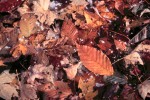Long-term studies of the movement and storage of nutrients in forests, soils and streams at the Hubbard Brook Experimental Forest indicate that calcium has been depleted from soils over the last 50 years. This depletion is due, in part, to atmospheric inputs of strong acids (acid rain). These acids leach base cations (calcium, magnesium, potassium and sodium from soil into streamwater. Loss of base cations reduces percent base saturation and diminishes soil fertility.
Calcium is the predominant base cation in soils and stream water. In New England ecosystems, calcium is primarily derived from the weathering of calcium-silicate minerals present in glacial till or bedrock. Calcium is an essential plant nutrient required for the formation of cell walls and membranes, the synthesis of important compounds and the regulation of cell permeability. Trees require calcium to form wood. Calcium also acts as a buffer, neutralizing inputs of acid from precipitation.
To investigate the consequences of calcium loss in a northern hardwood ecosystem, scientists from the U.S.D.A. Forest Service and cooperating institutions including Cornell University, the Institute of Ecosystem Studies, Syracuse University, and the University of Michigan, experimentally added 55 tons of calcium to a 12 hectare watershed (watershed 1) in the Hubbard Brook Experimental Forest (HBEF). The calcium was added in the form of Wolastonite, a calcium silicate mineral, to match natural sources of calcium at the site as closely as possible. The Wollastonite was applied by helicopter in one–ton increments. Prior to the application it was pelletized with a biodegradable binder to minimize wind dispersal.
Over the next 50 years, researchers at HBEF will investigate the response of soil, water and forest organisms to the addition of calcium. Results of this study will provide insight into the cumulative effects of disturbance and atmospheric deposition on forest health and ecosystem function in northern hardwood forests and on the biogeochemistry of nutrient base cations. The study will also provide information on the sustainability of northern hardwood forests growing on soils like those at Hubbard Brook and on the ability of forest ecosystems to recover from the effects of acid rain. Moreover, the study results may inform environmental policy and forest management practices. This experiment was funded by the National Science Foundation.

 Enlarge this image
Enlarge this image
